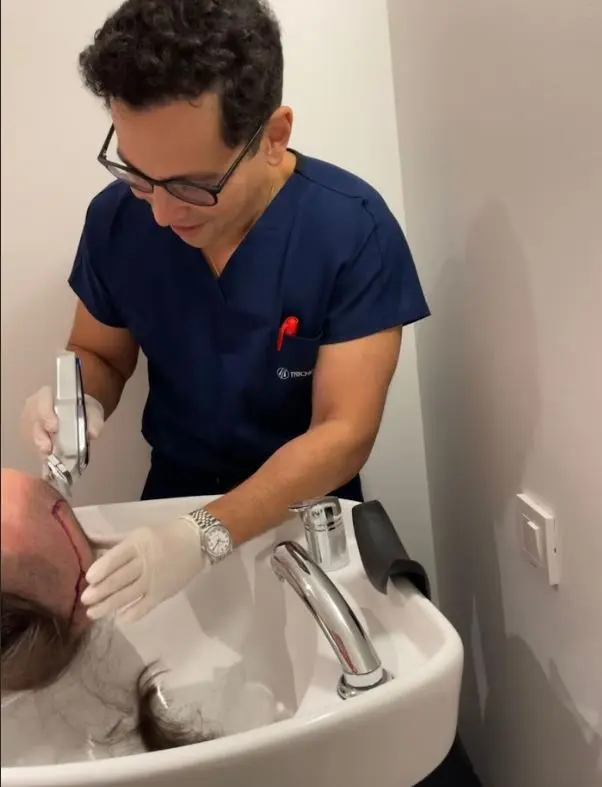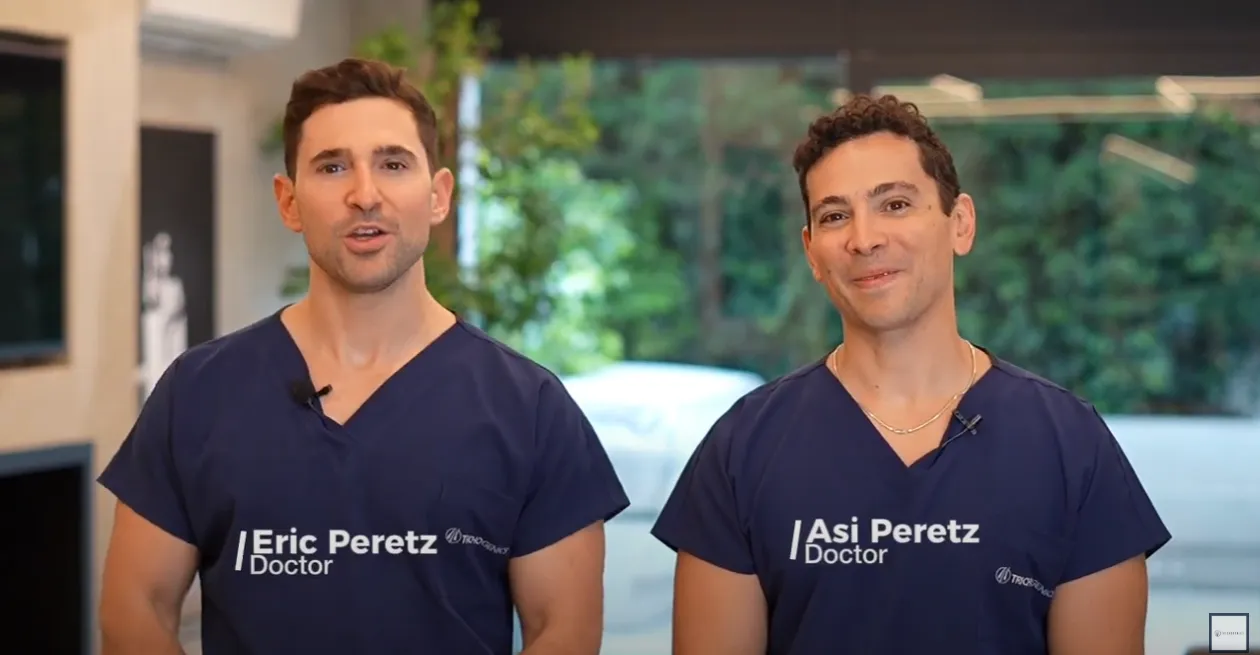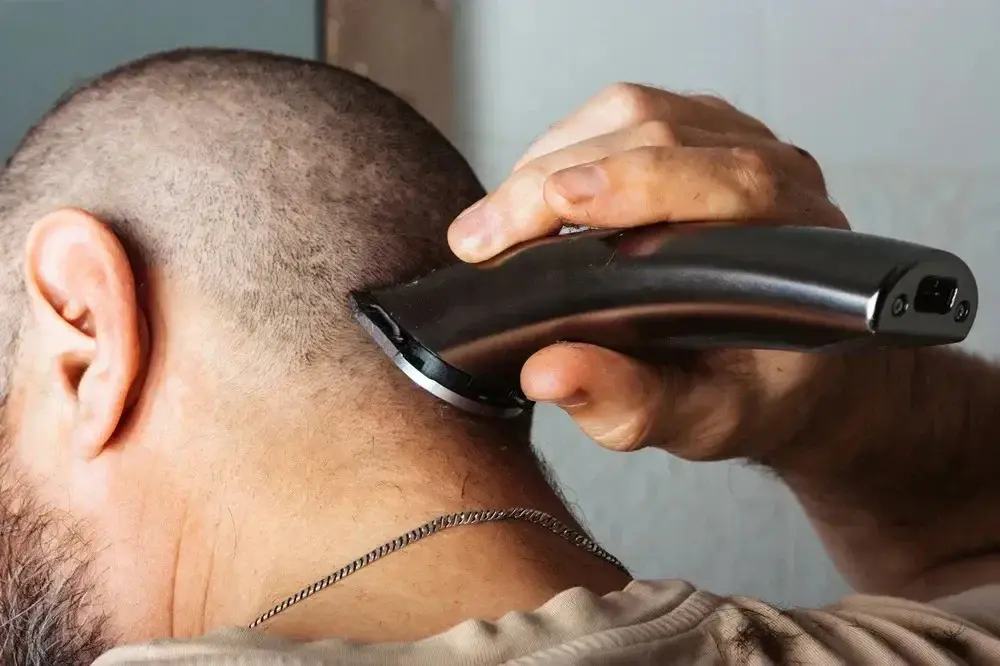At Trichogenics, Dr. Asi Peretz and Dr. Eric Peretz lead our team. We focus on advanced hair restoration surgery. Our surgeries are done only by doctors in Greece and Israel.
Patients often wonder how soon they can resume shaving their head after hair transplant. The answer depends on healing progress, but most specialists recommend waiting about three to four weeks before trimming the scalp. This helps the new hair grafts and follicular units settle in the area. It reduces the chance of irritation or damage.
Once your surgeon confirms that the skin is healed and sensitivity is gone, shaving can be done safely using gentle tools and proper technique.
Key Takeaways
- Wait at least three to four weeks before shaving head after hair transplant to allow the grafts and scalp to heal fully.
- Using an electric trimmer instead of a razor helps protect the recipient area and prevents irritation during early recovery.
- In FUE hair transplant procedures, healing is typically faster, but always confirm with your hair transplant surgeon before shaving.
- Shaving your head bald after hair transplant too soon can damage grafts and delay hair growth, so follow your doctor’s guidance closely.
- Choosing a medically supervised clinic like Trichogenics in Greece or Israel ensures safe, doctor-performed treatment—unlike unregulated clinics in Turkey.
When Is It Safe to Shave After a Hair Transplant?
After hair transplant surgery, patience is key. The hair grafts placed in the recipient area are fragile for the first few weeks. Shaving too soon can harm the new hair follicles and slow recovery.
Most patients can safely shave their head around three to four weeks after surgery, but this depends on the type of hair transplant procedure performed and the speed of healing. A hair transplant surgeon should confirm that your scalp is ready before you use any shaving tool.
Can you shave or buzz cut after a hair transplant?
Yes—but only after full healing. Using an electric trimmer instead of a razor is safer in the early months. This avoids pulling on delicate grafts and reduces the risk of irritation or infection. Always check with your surgeon first.
When to shave head after FUE hair transplant
In an FUE procedure, the donor and recipient areas usually heal faster. Most patients can resume gentle shaving about one month after surgery. Waiting ensures that follicular units are stable and the hair grows naturally.

Healing signs before shaving
Before you shave again, make sure:
- All scabs have fallen off naturally.
- The scalp is no longer red, swollen, or tender.
- The hair short areas feel smooth and stable.
Can I shave my head after 1 year of hair transplant?
Yes. After a full year, the grafts are permanent and fully integrated into your scalp. At this point, you can style or shave your hair freely without risking any damage.
Risks and Precautions Before Shaving
@trichogenics Do you need to shave your hair to get a hair transplant? Dr Asi Peretz explains. #trichogenics #hairtransplant #hairtransplantsurgery #hairtransplantturkey #hairtransplantgreece #hairloss #hairlosssolutions #hairlossremedy #hairfall #hairfallsolution #fyp
♬ original sound - Trichogenics
Shaving head bald after hair transplant
Going completely bald too soon after your surgery can damage the hair grafts and expose healing skin to irritation or infection. Always follow your surgeon’s instructions before using a razor or trimming tool.
Shaving after hair loss or failed transplant
Patients who experienced hair loss or a failed transplant may be tempted to shave everything to start over. At Trichogenics, we advise first evaluating the scalp’s condition. Some areas may still contain active follicles that can recover with the right treatment plan.
Mistakes that can damage transplanted grafts
Avoid these common mistakes:
- Using sharp razors on healing skin.
- Applying strong pressure during shaving.
- Ignoring redness or small wounds.
- Each can interfere with the recovery of transplanted follicular units and compromise your final results.
How to Shave Safely After a Hair Transplant
Best tools and gentle shaving techniques
Use an electric trimmer instead of a blade during the first few months. Move slowly in the direction of hair growth to avoid tugging. Keep the trimmer sanitized to prevent infections.
Aftercare tips to protect the scalp
- Apply a mild, doctor-approved moisturizer after shaving.
- Avoid sun exposure for at least 48 hours.
- Do not use alcohol-based aftershaves on the recipient area.
- These steps help the skin recover and maintain a healthy environment for continued hair growth.
Does Transplanted Hair Grow After Shaving?
Understanding graft growth and shock loss
After shaving, your shaved head after hair transplant might appear thin temporarily. This is normal. Shock loss—a temporary shedding phase—can happen as new grafts adjust. Don’t worry; hair grows back stronger in the following months.
Long-term maintenance and natural results
Once the hair follicles are fully healed, shaving does not affect their growth. The transplanted hair behaves just like natural hair—it will regrow at the same pace. Most patients enjoy thicker, denser coverage within a year after surgery.
Expert Advice From Trichogenics Doctors
Medically reviewed by Dr. Asi and Dr. Eric Peretz
At Trichogenics, our founders, Dr. Asi Peretz and Dr. Eric Peretz, perform every hair restoration surgery themselves. This doctor-led approach ensures safety, precision, and consistent results. Unlike commercial clinics in Turkey, where operations are often handled by unqualified technicians, our procedures meet strict European medical standards in Greece and Israel.
When to contact your surgeon
If you notice redness, swelling, or unusual sensitivity while shaving hair after hair transplant, contact your doctor immediately. It’s better to delay shaving than risk your final result.
Why Choose Trichogenics?

All procedures are performed only by doctors
The uniqueness of Trichogenics lies in its strict medical process—only certified doctors perform every transplant. No technicians or unqualified assistants are involved. Choosing a clinic with proven experience in hair transplants can make all the difference.
Meet Dr. Asi and Dr. Eric Peretz
The two doctors leading Trichogenics—Dr. Asi Peretz and Dr. Eric Peretz—are recognized leaders in the field. Their extensive experience, attention to detail, and focus on natural results make Trichogenics the best choice.
Celebrity Hair Transplants
Who has undergone the procedure at Trichogenics? The answer is clear: a safe, professional clinic that delivers results that look great even under camera lights.
Contact Trichogenics today to schedule a personal consultation and get a clear, doctor-led plan for your hair restoration.
Lorem ipsum dolor sit amet, consectetur adipiscing elit. Ut elit tellus, luctus nec ullamcorper mattis, pulvinar dapibus leo.



